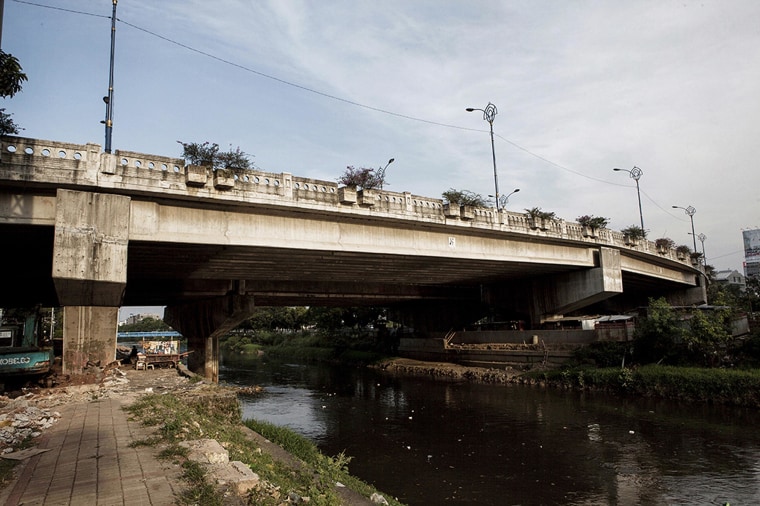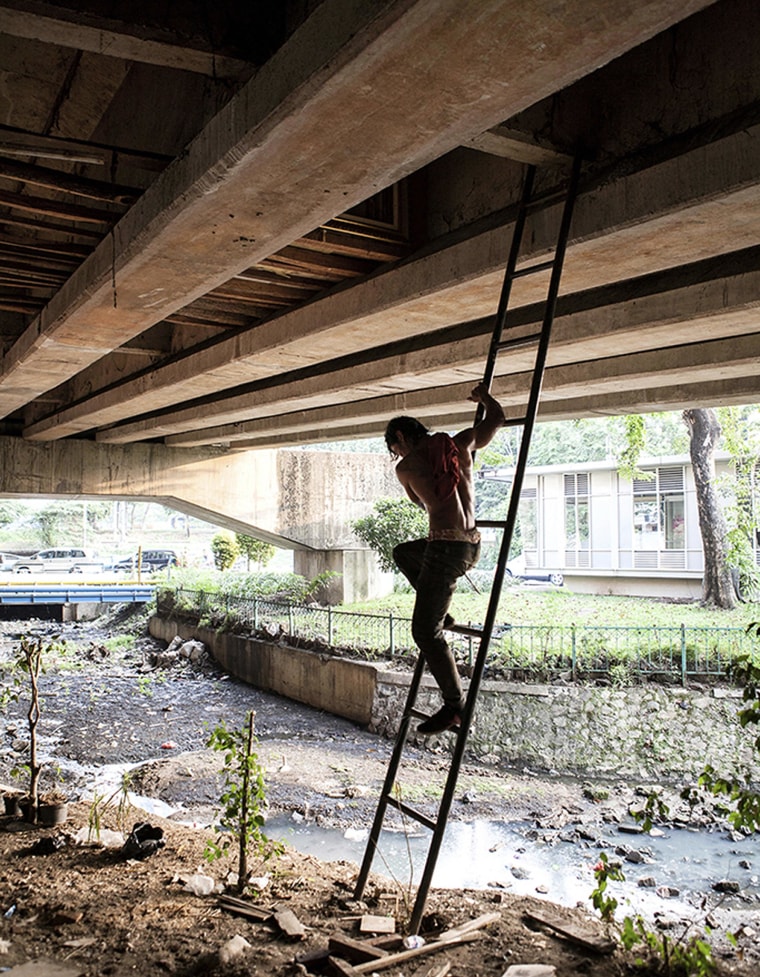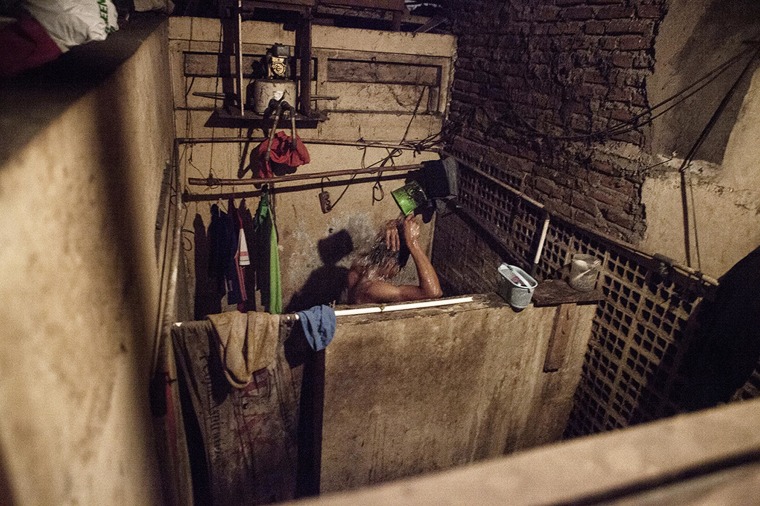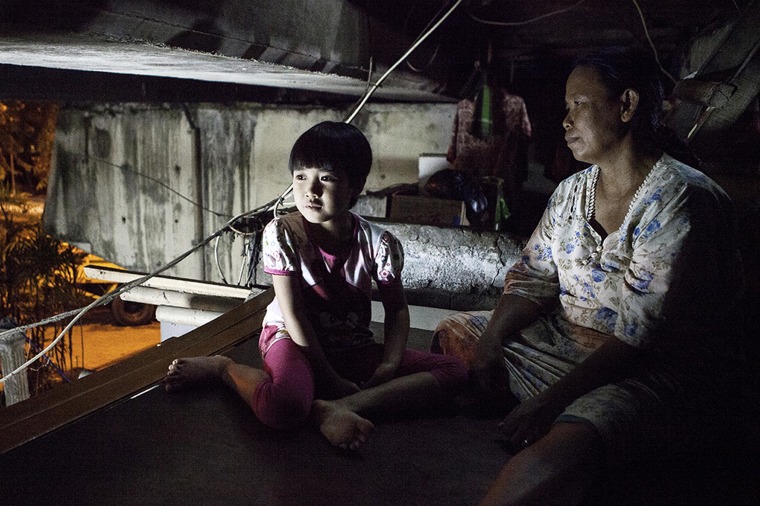JAKARTA, Indonesia — From above, it looks like an ordinary urban bridge, six lanes of traffic, connecting two of the swankiest districts in this sprawling city of 9.6 million.
On one side is Kuningan business district: luxury apartments, five-star hotels and embassies.
On the other is Menteng, known as Jakarta’s Beverly Hills: old Dutch-colonial-era mansions home to foreign diplomats, senior officials and the capital’s richest residents.
Between the two is the Kuningan bridge.
Inside the bridge — yes, like, literally inside the bridge, in the cubbies formed by its girders — live more than 100 people, almost exclusively men.
They’re the guys who clean the city.

Passers-by would hardly suspect the existence of this improvised apartment complex. You could drive or walk over it for years — many Indonesians do — and not notice a thing.
Underneath, it takes a while to get used to the relentless rumble of traffic.
When a traffic light changes, two-stroke motorcycles come flying overhead, their engines shrieking like a tsunami of bumble bees. The rooms shake when trucks or buses pass. When it rains, the heat and humidity seem almost unbearable. The water nearby is a fetid marsh that floods in the rainy season and swarms with mosquitoes.
All in all, it’s no idyllic riverside resort. But the locals don’t seem to mind. It’s home and they’re proud of it.
Karno, from Brebes, in central Java, has been living here for thirty years. He says that when he first moved in, there was nothing but the bridge’s concrete walls. “It looked like a shanty town. We made it into what it is now,” he says.
“What it is now” resembles a dilapidated tree house more than a residential building, but Karno explains the improvements. The men (and a couple of women) now have toilets and showers under the bridge, as well as a small mosque that was built five years ago. Behind it is the bridge’s “entrance.” Climbing a ladder, Karno arrives in a room suspended about ten feet above the ground, where a dozen night-shift workers lie half asleep, play chess or watch TV.
The “tenants” have built the wooden floor. They have also equipped this “living room” with a television, a sound system, a few fans and outlets for lamps and mobile phones. They explain that they bribe an electricity employee for access to more than the 450 watts of power wired in by their employers.

This may sound like squatting. It’s actually very organized. The tenants here work for the city. Their employer, a government subcontractor, “houses” them here.
When asked about it, the municipality argued it wasn’t directly responsible for these workers, and wouldn’t discuss its subcontractor’s curious housing choice, nor these city workers’ questionable living conditions.
And so the men make do with what they have.
Using the bridge structure, the richest tenants have built themselves tiny private rooms. Below or alongside these is a communal room, where those who can’t afford their own space sleep “packed like sardines,” says Fudoli, a 43-year-old gardener. They don’t pay rent, but construction materials can be prohibitively expensive to workers on their budget.
These days, there’s an entrance next to the mosque that’s the only way in on one side of the bridge. Before 2012, many residents lived in rooms reached via ladders from below, but floods made such access impossible. Workers also said their employers didn’t like the ladders, claiming they were too “visible” to passers-by.
The 70 people living on the Menteng end of the bridge work for the municipality’s parks department. The other end is occupied by employees of the sanitation department.
“We’re part of the same football league. We sometimes play together,” says Fudoli.
There are few women or children here because the employers forbid bringing family.
Karno says he only sees his wife and three children every two to three months, when he goes back to his hometown. Only a few “privileged seniors,” such as Waljum, who sits outside the food stall his wife Sutinah manages, have their families close to them.

In the living room, where the TV sits and everyone is welcome, the workers talk politics. This is an important political year, with legislative elections in April and presidential in July. Two weeks ago, the main opposition party announced Jakarta’s popular governor Joko Widodo as its candidate for the presidential elections. That has left the bridge tenants disappointed. “We would have preferred him to finish his mandate in Jakarta before running for president. There is a lot of work to do here,” says Fudoli. Still, most workers agree they would vote for him.
While they admit their living standards are not ideal, they say they are “grateful” to their employers for providing them with a free place to live. “This is enough for us, it’s better than having to pay rent,” says Fudoli. He says they make 70,000 Indonesian rupees a day ($6) but often work more than one shift, and still struggle to save money to bring back home to their families.
Like Fudoli, Karno and the rest of the workers they call “family” after years of communal life, tens of thousands of new migrants come to Jakarta every year in search of work.
Fudoli, who hails from Pemalang in central Java, says those who come to Jakarta have no other choice to make ends meet. “People prefer to stay in their village. I would have stayed there if I had land, but for those who don’t, there is just no work back home.”

This story originally appeared in GlobalPost.
More stories from GlobalPost:
Hungarian Elections: How to Steal a Constitution
Q&A: What's Next for Venezuela?
Day 1,111: Syrian Artists Complete Mural; Rebels Comment on Kardashian
